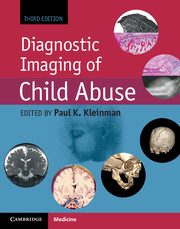Book contents
- Frontmatter
- Dedication
- Contents
- List of Contributors
- Editor’s note on the Foreword to the third edition
- Foreword to the third edition
- Foreword to the second edition
- Foreword to the first edition
- Preface
- Acknowledgments
- List of acronyms
- Introduction
- Section I Skeletal trauma
- Section II Abusive head and spinal trauma
- Chapter 16 Abusive head trauma: clinical, biomechanical, and imaging considerations
- Chapter 17 Abusive head trauma: scalp, subscalp, and cranium
- Chapter 18 Abusive head trauma: extra-axial hemorrhage and nonhemic collections
- Chapter 19 Abusive head trauma: parenchymal injury
- Chapter 20 Abusive head trauma: intracranial imaging strategies
- Chapter 21 Abusive craniocervical junction and spinal trauma
- Section III Visceral trauma and miscellaneous abuse and neglect
- Section IV Diagnostic imaging of abuse in societal context
- Section V Technical considerations and dosimetry
- Index
- References
Chapter 16 - Abusive head trauma: clinical, biomechanical, and imaging considerations
from Section II - Abusive head and spinal trauma
Published online by Cambridge University Press: 05 September 2015
- Frontmatter
- Dedication
- Contents
- List of Contributors
- Editor’s note on the Foreword to the third edition
- Foreword to the third edition
- Foreword to the second edition
- Foreword to the first edition
- Preface
- Acknowledgments
- List of acronyms
- Introduction
- Section I Skeletal trauma
- Section II Abusive head and spinal trauma
- Chapter 16 Abusive head trauma: clinical, biomechanical, and imaging considerations
- Chapter 17 Abusive head trauma: scalp, subscalp, and cranium
- Chapter 18 Abusive head trauma: extra-axial hemorrhage and nonhemic collections
- Chapter 19 Abusive head trauma: parenchymal injury
- Chapter 20 Abusive head trauma: intracranial imaging strategies
- Chapter 21 Abusive craniocervical junction and spinal trauma
- Section III Visceral trauma and miscellaneous abuse and neglect
- Section IV Diagnostic imaging of abuse in societal context
- Section V Technical considerations and dosimetry
- Index
- References
Summary
Introduction
Abusive head trauma (AHT) is a medical diagnosis that encompasses data from clinical and experimental studies. The neuroimaging evaluation is a critical piece of the diagnosis, but should not be considered separate from the biomechanical research, clinical history, laboratory testing, and any other investigative information that is felt to be clinically warranted. Furthermore, many clinical subspecialties in addition to pediatrics and medical imaging offer supportive diagnostic information that must be incorporated in the overall analysis of a case. The ophthalmologist, critical care specialist, emergency medicine physician, trauma surgeon, and neurosurgeon play vital roles in the clinical assessment. Investigative collaboration requires a close relationship with biomechanical engineering, law enforcement, Child Protective Services (CPS), and forensic pathology. Child abuse is unique compared with other diagnostic processes because there is no single or combined set of clinical indicators that proves a child has been abused. In fact, there are many medical conditions that can mimic some or all of the indicators seen in child abuse. Laboratory testing and clinical evaluation is essential in the identification of confounding medical conditions. However, in the context of a traumatic brain injury (TBI) in an infant or young child who, in the absence of other medical factors, does not have a sufficient history of trauma to account for the injuries, AHT leads the differential diagnosis.
- Type
- Chapter
- Information
- Diagnostic Imaging of Child Abuse , pp. 345 - 356Publisher: Cambridge University PressPrint publication year: 2015
References
- 1
- Cited by



